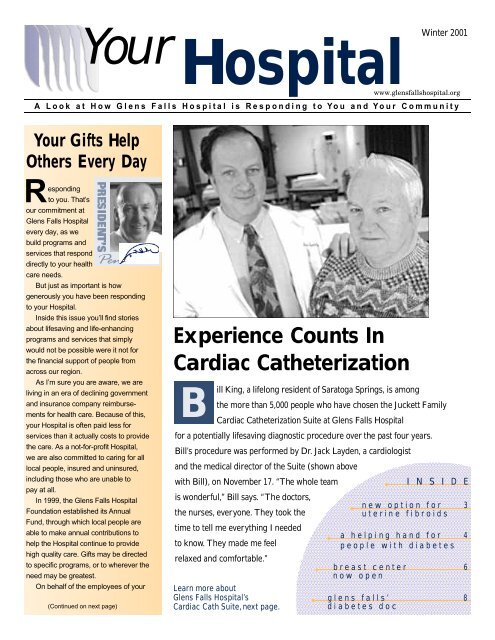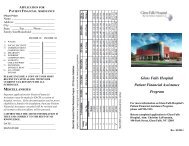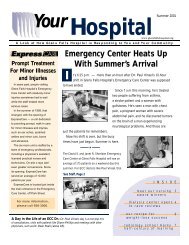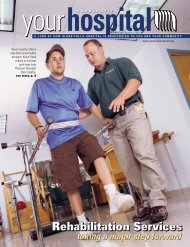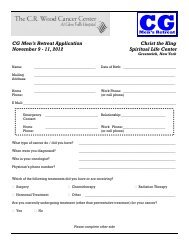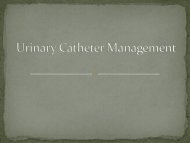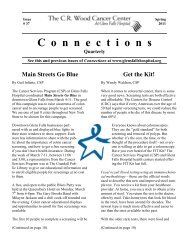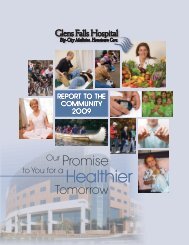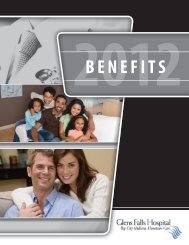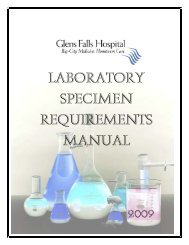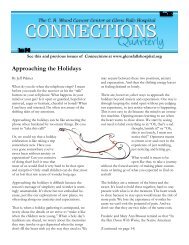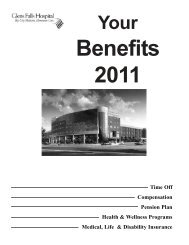Experience Counts In C a rdiac Catheterization - Glens Falls Hospital
Experience Counts In C a rdiac Catheterization - Glens Falls Hospital
Experience Counts In C a rdiac Catheterization - Glens Falls Hospital
You also want an ePaper? Increase the reach of your titles
YUMPU automatically turns print PDFs into web optimized ePapers that Google loves.
Responding<br />
to you. T h a t ’s<br />
our commitment at<br />
<strong>Glens</strong> <strong>Falls</strong> <strong>Hospital</strong><br />
every day, as we<br />
build programs and<br />
services that respond<br />
directly to your health<br />
care needs.<br />
But just as important is how<br />
generously you have been responding<br />
to your <strong>Hospital</strong>.<br />
<strong>In</strong>side this issue you’ll find stories<br />
about lifesaving and life-enhancing<br />
programs and services that simply<br />
would not be possible were it not for<br />
the financial support of people from<br />
across our region.<br />
As I’m sure you are aware, we are<br />
living in an era of declining government<br />
and insurance company reimburse-<br />
ments for health care. Because of this,<br />
your <strong>Hospital</strong> is often paid less for<br />
services than it actually costs to provide<br />
the care. As a not-for-profit <strong>Hospital</strong>,<br />
we are also committed to caring for all<br />
local people, insured and uninsured,<br />
including those who are unable to<br />
pay at all.<br />
<strong>In</strong> 1999, the <strong>Glens</strong> <strong>Falls</strong> <strong>Hospital</strong><br />
Foundation established its A n n u a l<br />
Fund, through which local people are<br />
able to make annual contributions to<br />
help the <strong>Hospital</strong> continue to provide<br />
high quality care. Gifts may be directed<br />
to specific programs, or to wherever the<br />
need may be greatest.<br />
You r<br />
A L o o k a t H o w G l e n s F a l l s H o s p i t a l i s R e s p o n d i n g t o Yo u a n d Y o u r C o m m u n i t y<br />
Your Gifts Help<br />
Others Every Day<br />
Pen<br />
On behalf of the employees of your<br />
(Continued on next page)<br />
Ho s p i t a l<br />
www.glensfallshospital.org<br />
<strong>Experience</strong> <strong>Counts</strong> <strong>In</strong><br />
C a <strong>rdiac</strong> <strong>Catheterization</strong><br />
B<br />
ill King, a lifelong resident of Saratoga Springs, is among<br />
the more than 5,000 people who have chosen the Juckett Family<br />
C a <strong>rdiac</strong> <strong>Catheterization</strong> Suite at <strong>Glens</strong> <strong>Falls</strong> <strong>Hospital</strong><br />
for a potentially lifesaving diagnostic pro c e d u re over the past four years.<br />
B i l l ’s pro c e d u re was perf o rmed by Dr. Jack Layden, a cardiologist<br />
and the medical director of the Suite (shown above<br />
with Bill), on November 17. “The whole team<br />
is wonderful,” Bill says. “The doctors,<br />
the nurses, everyone. They took the<br />
time to tell me everything I needed<br />
to know. They made me feel<br />
relaxed and comfort a b l e . ”<br />
L e a rn more about<br />
<strong>Glens</strong> <strong>Falls</strong> <strong>Hospital</strong>’s<br />
C a <strong>rdiac</strong> Cath Suite, n ext page.<br />
Winter 2001<br />
I N S I D E<br />
n e w o p t i o n f o r 3<br />
u t e r i n e f i b r o i d s<br />
a h e l p i n g h a n d f o r 4<br />
p e o p l e w i t h d i a b e t e s<br />
b r e a s t c e n t e r 6<br />
n o w o p e n<br />
g l e n s f a l l s ’ 8<br />
d i a b e t e s d o c
C a <strong>rdiac</strong> Cath Staff<br />
t h<br />
P e rf o rms 5,000<br />
P ro c e d u re<br />
The staff of the Juckett Family Ca<strong>rdiac</strong> <strong>Catheterization</strong><br />
Suite at <strong>Glens</strong> <strong>Falls</strong> <strong>Hospital</strong> reached a noteworthy mile-<br />
stone in recent weeks, as they perf o rmed the 5,000th<br />
p ro c e d u re since the Lab’s opening in 1996.<br />
“When it comes to an intricate pro c e d u re like this, there<br />
is no substitute for experience,” says Dr. Jack Layden,<br />
medical director of the Suite and a partner in Adiro n d a c k<br />
C a rdiology Associates in <strong>Glens</strong> <strong>Falls</strong>. “Our staff is very<br />
experienced and very skillful.”<br />
C a <strong>rdiac</strong> catheterization is used to evaluate how well a<br />
h e a rt is working, and to diagnose blockages or abnorm a l i-<br />
ties. The pro c e d u re is perf o rmed by a cardiologist who<br />
uses X-ray images to guide a thin catheter to the heart<br />
t h rough an art e ry in the groin. The cardiologist then<br />
injects a dye that allows him to see — through the X-ray<br />
image — how well the heart is working.<br />
Prior to the opening of our Suite, people from the<br />
g reater <strong>Glens</strong> <strong>Falls</strong> area requiring a ca<strong>rdiac</strong> catheterization<br />
had to drive or be taken by ambulance to an Albany are a<br />
hospital. The test takes only about fifteen minutes, but the<br />
drive for some would take as long as two hours. The time<br />
spent waiting for a pro c e d u re has also been re d u c e d .<br />
“ B e f o re we opened, local people had to wait a couple of weeks<br />
to have the pro c e d u re done at an Albany area hospital,” says Dr. Layden. “Now<br />
we can schedule them as early as the next day and they don’t have to drive all<br />
the way to Albany.<br />
“Most important, because we can get the test done sooner, we can catch<br />
h e a rt disease when it’s treatable. It might sound cliché, but the time we save<br />
could save a life.”<br />
The <strong>Glens</strong> <strong>Falls</strong> region is fortunate to<br />
have the services of two outstanding<br />
groups of cardiologists. They are:<br />
<strong>Glens</strong> <strong>Falls</strong> A s s o c i ates<br />
in Card i o l ogy<br />
1 Broad Street, Suite 202, <strong>Glens</strong> <strong>Falls</strong><br />
7 9 3 - 1 0 8 3<br />
Jonathan M. DeSantis, M.D., F. A . C . C .<br />
G re g o ry A. Kelly, M.D.<br />
<strong>Glens</strong> <strong>Falls</strong>’ Cardiologists<br />
c a r d i a c c a t h e t e r i z a t i o n<br />
A d i ro n d a ck Card i o l ogy A s s o c i at e s<br />
90 South Street, <strong>Glens</strong> <strong>Falls</strong><br />
792-1233 or 677-2154.<br />
James F. Morr i s s e , yM.D.,<br />
F. A . C . C .<br />
David W. Schwenker, M.D., F. A . C . C .<br />
John J. Layden, M.D., F.A.C.C.<br />
Peter R. Gray, Ph.D., F. A . C . C .<br />
Michael A. Layden, M.D., F. A . C . C .<br />
David A. Judkins, M.D., F. A . C . C .<br />
Scott M. Munro, M.D.<br />
Our Ca<strong>rdiac</strong> Cath staff includes (clockwise from front): Sharo n<br />
F a rrell, RN; Cardiology Services Director Carol Forman, RN;<br />
Michele Harding, an RN and re g i s t e ed r cardiovascular invasive<br />
specialist (RCIS); Fred Barss, an RCIS and re g i s t e ed r re s p i r a t o ry<br />
therapist; Melissa Potter, an RCIS and licensed radiologic<br />
technologist (LRT); Ron Peltier, RN; and Samantha David, LRT,<br />
RCIS. Missing from the photo are: Jackie DeCunzo, RN; Mary<br />
Flagel, RN; Gerri Sprague, RN; Carolyn Wickes, RN; and Clinical<br />
Manager Barbara McDermott, RN, RCIS.<br />
PRESIDENT’S PEN<br />
(Continued from front)<br />
<strong>Hospital</strong>, and the board of directors of the<br />
<strong>Glens</strong> <strong>Falls</strong> <strong>Hospital</strong> Foundation, I thank<br />
you for your generous support. And, as<br />
we begin the new year, I hope you will<br />
again consider how your gifts to the<br />
Foundation will benefit your <strong>Hospital</strong> and<br />
your future.<br />
Gifts may be sent to the <strong>Glens</strong> <strong>Falls</strong><br />
<strong>Hospital</strong> Foundation, 12 Warren Street,<br />
<strong>Glens</strong> <strong>Falls</strong>, NY, 12801, or through our<br />
Web site at w w w. gl e n s fa l l s h o s p i t a l . g. o r<br />
Best of health,<br />
David G. Kruczlnicki
Radiology technologies such as<br />
X-ray and ultrasound have been<br />
used for many years to identify<br />
medical problems.<br />
But for the past decade these<br />
technologies have been increasingly<br />
used for treatment as well as<br />
diagnosis, through the practice of<br />
interventional radiology — a medical<br />
specialty in which X-ray and<br />
ultrasound technologies are used to<br />
guide catheters and other tiny<br />
instruments into arteries and other<br />
parts of the body to treat conditions<br />
that once required surgery.<br />
<strong>Glens</strong> <strong>Falls</strong> <strong>Hospital</strong> added this<br />
innovative treatment option to its<br />
array of patient services in the<br />
mid-1990s, recruiting interventional<br />
radiologist Dr. Richard<br />
Dimick to oversee the<br />
creation and serve as<br />
Medical Director of our<br />
$1.2-million <strong>In</strong>ter-<br />
ventional Radiology Lab.<br />
It is estimated that as many as 20% of women in their 20s,<br />
30% of women in their 30s and 40% of women in their 40s<br />
are living with uterine fibroids.<br />
These non-cancerous tumors, which grow from the<br />
muscular walls of the uterus, can result in heavy bleeding,<br />
pelvic pain, bloating and anemia (the loss of red blood cells).<br />
H i s t o r i c a l l , ythe<br />
standard course of action when these<br />
symptoms persist has been a hysterectomy, the surgical<br />
removal of the uterus.<br />
But now, there is a new, non-surgical treatment alternative<br />
available at <strong>Glens</strong> <strong>Falls</strong> <strong>Hospital</strong> that preserves the uterus —<br />
i n t e r v e n t i o n a l r a d i o l o g y<br />
Radiology: It’s Not Just For Diagnosis Any More<br />
D r. Dimick was joined in <strong>Glens</strong> <strong>Falls</strong><br />
in 1997 by fellow interventional<br />
radiologist Dr. Marc Meacham. Both<br />
doctors are partners in A d i r o n d a c k<br />
Radiology A s s o c i a t e s .<br />
The insertion of a catheter or<br />
other device typically requires only a<br />
small (approximately 1/8th of an<br />
inch) incision in the skin. The pain<br />
and recovery time is often much less<br />
than with surgery, and there are<br />
fewer associated risks.<br />
<strong>In</strong> recent years, Dr. Dimick says,<br />
he and Dr. Meacham have used<br />
New Procedure Offers<br />
Alternative to Hysterectomy for<br />
Women with Uterine Fibroids<br />
and the possibility of childbirth. Called uterine artery<br />
embolization, the procedure is a form of interventional<br />
radiology in which a tiny catheter is guided into the uterine<br />
artery through a small incision (about 1/8th of an inch long)<br />
made in the groin area. The doctor then injects tiny plastic<br />
particles (about the size of a grain of sand) into the artery,<br />
blocking the flow of blood to the fibroid and effectively killing<br />
the tumor. The entire procedure takes approximately one<br />
h o u r, and most women will spend just one night in the<br />
hospital.<br />
interventional radiology to unclog<br />
arteries, kill tumors, stop excessive<br />
post-partum bleeding and treat<br />
such diverse ailments as persistent<br />
nosebleeds and a gunshot wound<br />
to the kidney.<br />
The <strong>In</strong>terventional Radiology Lab<br />
is staffed by Christine Moynihan,<br />
Licensed Radiologic Te c h n o l o g i s t<br />
(LRT); Michelle Helmecke, LRT;<br />
Karen Carpenter, LRT; Karin<br />
Hazlitt, LRT: Karen <strong>In</strong>gignoli,<br />
Certified Registered Nurse; and<br />
Richard Gale, RN.<br />
<strong>In</strong>terventional radiologists Dr. Marc Meacham (left) and Dr. Richard<br />
Dimick use tiny catheters the size of a button hole to treat a wide<br />
variety of ailments.<br />
<strong>Glens</strong> <strong>Falls</strong> <strong>Hospital</strong>’s interventional radiologists Dr.<br />
Richard Dimick and Dr. Marc Meacham urge women with<br />
symptoms of uterine fibroids to consult with their doctor<br />
i m m e d i a t e l . yThey<br />
point out that excessive vaginal bleeding<br />
and pelvic discomfort may be the result of other conditions.<br />
For more information on uterine fibroids, visit the “Healthy<br />
Woman” section of our Web site at w w w. g l e n s f a l l s h o s p i t a l . o rg .
H e l p i n g<br />
People with<br />
D i a b e t e s<br />
H e l p<br />
T h e m s e l v e s<br />
Education is at Forefront<br />
of New Regional Center<br />
Janet Dureau developed<br />
diabetes as a result of a heart<br />
transplant in 1990. A doctor at the<br />
New York City-area hospital in<br />
which her transplant was per-<br />
f o rmed showed her how to give<br />
herself an insulin injection, hand-<br />
ed her a prescription for syringes<br />
and wished her well. “I was told<br />
nothing about diabetes,” the<br />
T h u rman resident says.<br />
S h e ’s not alone. Many people with<br />
diabetes go through life with only a cur-<br />
s o ry understanding of the disease that in<br />
so many ways controls their life. Other<br />
people go years without even re a l i z i n g<br />
they have the disease. <strong>In</strong> either case,<br />
the consequences can be severe<br />
complications and even death.<br />
<strong>Glens</strong> <strong>Falls</strong> <strong>Hospital</strong> is changing all<br />
that, with the recent opening of our<br />
Regional Diabetes Center at our new<br />
r e g i o n a l d i a b e t e s c e n t e r<br />
R e g i s t e ed r Dietitian Rebecca Mahar (left) helps Janet Dureau and other local people with<br />
diabetes plan balanced meals to assist in controlling their blood glucose.<br />
B road Street Campus in <strong>Glens</strong> <strong>Falls</strong> (for-<br />
merly known as the Nort h c a re Building).<br />
The Center is dedicated to helping<br />
people determine if they are at incre a s e d<br />
risk for diabetes, and to helping people<br />
with diabetes understand their disease<br />
and better manage their blood glucose.<br />
“People with diabetes don’t have to be<br />
victims,” says Director Sandra McNeil.<br />
“ You can have the disease without being<br />
a victim, but you have to help yourself.”<br />
N u m e rous studies have shown that<br />
people with diabetes who combine<br />
c a reful blood glucose monitoring and<br />
healthy lifestyle choices with their use<br />
of insulin or other medications can<br />
significantly reduce their risk of<br />
debilitating or deadly complications, such
as kidney failure, blindness, and nerv e<br />
damage that results in amputation.<br />
The centerpiece of the Center’s<br />
s e rvices is a 10-hour Diabetes Self-<br />
“They changed my life. They<br />
really did. I have energy now,<br />
I can think more clearly ...<br />
they saved me.”<br />
Management Education Pro g r a m ,<br />
designed to help people gain maximum<br />
c o n t rol over their disease. Specialized<br />
p rograms are off e red on such topics as<br />
insulin administration, blood glucose<br />
monitoring, nutrition, and diabetes care<br />
for children. Diabetes risk assessments<br />
and support groups are also pro v i d e d .<br />
The Center’s staff includes: the<br />
husband and wife team of Medical<br />
D i rector Joe Galindo, M.D., an<br />
endocrinologist and diabetologist<br />
(see back page), and Self-Management<br />
P rogram Coordinator Emily Galindo, a<br />
nurse practitioner and certified diabetes<br />
educator; along with re g i s t e red dietitians<br />
Rebecca Mahar, Lisa Hodgson and Pam<br />
Dixon. Support services are provided by<br />
an exercise physiologist, pharmacist and<br />
behavioral health pro f e s s i o n a l .<br />
<strong>In</strong> addition to providing patient educa-<br />
tion, the staff works closely with the<br />
families of people with diabetes, and<br />
o ffers specialized consultations to are a<br />
physicians interested in learning more<br />
about the disease.<br />
Janet Dureau enrolled in the<br />
Self-Management Education Pro g r a m<br />
last summer after a period of time in<br />
which her blood glucose was wildly<br />
out of control, leaving her larg e l y<br />
bedridden.<br />
Less than six months later, she says<br />
s h e ’s lost weight, improved her diet and<br />
l e a rned more than she ever thought<br />
possible about the disease she’s lived<br />
with for a decade.<br />
“They changed my life,” she says.<br />
“They really did. I have energy now, I can<br />
think more clearly . . . they saved me.”<br />
Janet Dureau reviews the corect procedure for monitoring her blood glucose with<br />
Diabetes Self-Management Program Coordinator Emily Galindo.<br />
New Diabetes<br />
Network Formed<br />
The staff of the Regional Diabetes<br />
Center works closely with the newly<br />
formed Seven County Diabetes<br />
Network, a state-funded program<br />
operated on the local level by <strong>Glens</strong><br />
<strong>Falls</strong> <strong>Hospital</strong> and other health care<br />
organizations.<br />
The Network’s objectives are to<br />
help people determine if they are<br />
at risk for diabetes, and to provide<br />
community education about the<br />
disease. For more information on<br />
the Diabetes Network, please call<br />
926-5920 or toll-free 1-800-965-5705.<br />
Doctor Starts, <strong>In</strong>vites<br />
Gifts to Diabetes Fund<br />
As a youngster growing up in<br />
<strong>Glens</strong> <strong>Falls</strong>, Dr. Joe Galindo came to<br />
think of city residents Martin and Rita<br />
Ouedekerk as “family, like an aunt<br />
and uncle to me.”<br />
S a d l y, Rita Oudekerk died in 1996<br />
due to complications from diabetes.<br />
<strong>In</strong> Rita’s memory, Dr. Galindo,<br />
a diabetes specialist and Medical<br />
Director of the Regional Diabetes<br />
Center at <strong>Glens</strong> <strong>Falls</strong> <strong>Hospital</strong>, has<br />
worked with the <strong>Glens</strong> <strong>Falls</strong> <strong>Hospital</strong><br />
Foundation to establish t h e<br />
Rita Ouedekerk Diabetes Fund<br />
to benefit the new center.<br />
Anyone interested in contributing<br />
to the Fund may send a check to<br />
the Rita Oudekerk Diabetes Fund, c/o<br />
<strong>Glens</strong> <strong>Falls</strong> <strong>Hospital</strong> Foundation, 12<br />
Warren Street, <strong>Glens</strong> <strong>Falls</strong>, NY 1 2 8 0 1 .
e a s t c e n t e r<br />
New Center<br />
Devoted to Breast Cancer Detection & Support<br />
<strong>Glens</strong> <strong>Falls</strong> <strong>Hospital</strong> has long been<br />
recognized for its innovative and successful<br />
p a t i e n t - c e n t e red approach to breast cancer<br />
detection, education, re s e a rch and treatment.<br />
N o w, we have taken our capabilities to<br />
another level with the opening of our new<br />
B reast Center.<br />
Thanks to the generous support of local people, the<br />
Center brings together all of our breast cancer education,<br />
s c reening, diagnostic and support services into one<br />
conveniently located, comfortably designed and<br />
technologically advanced facility, located just off the<br />
H o s p i t a l ’s main lobby.<br />
We have assembled a dedicated team of medical<br />
p rofessionals, equipped with the latest in breast scre e n-<br />
ing technology, to help local women detect breast cancer<br />
s o o n e r, fight it successfully and cope better emotionally<br />
during the diagnostic, treatment and re c o v e ry pro c e s s e s .<br />
S c reening appointments can be made by asking<br />
your primary care physician for a re f e rral to the Bre a s t<br />
Center at <strong>Glens</strong> <strong>Falls</strong> <strong>Hospital</strong>.<br />
Our Breast Center Te a m<br />
(clockwise from bottom<br />
left): Program Assistant<br />
Beatrice Didio,<br />
Mammogram Te c h n o l o g i s t<br />
Michelle Swart z ,<br />
Mammogram Te c h n o l o g i s t<br />
Cathy Potter, Mammogram<br />
Technologist Carol Ta n n e r,<br />
Ultrasound Te c h n o l o g i s t<br />
Connie Irish, Mammogram<br />
Technologist Tracey Blunt,<br />
P rogram Coordinator and<br />
R e g i s t e ed r Nurse Cathleen<br />
Howland, and Registered<br />
Nurse Linda Lansburg .<br />
“We’re there with information, we’re there to listen, and<br />
we’re there with a shoulder to lean on.”<br />
Cathleen Howland, RN, Breast Center Program Coordinator
Faster Diagnosis, Greater<br />
Understanding Are<br />
Goals of Breast<br />
Center Te a m<br />
T<br />
Studies have shown that the<br />
benefits of early breast cancer<br />
detection are significant:<br />
■ g reater survival rate;<br />
■ g reater chance of breast-saving<br />
s u rg e ry ;<br />
his year, one out of every<br />
10 women who have a<br />
mammogram will<br />
experience an “abnormal” finding.<br />
F o r t u n a t e l y, 90% of those women will<br />
not have breast cancer.<br />
Still, that period of time between the<br />
“abnormal” screening and the day that<br />
diagnostic testing is performed can be<br />
one of the most frightening and stressful<br />
experiences of a woman’s life.<br />
For women whose screenings are conducted<br />
at the new Breast Center at <strong>Glens</strong> <strong>Falls</strong> <strong>Hospital</strong>, this<br />
period of uncertainty will be shorter than ever.<br />
Our team, made up of certified mammogram and<br />
ultrasound technologists and nurses, works closely with the<br />
radiologist and reports abnormal findings to the woman’s<br />
primary care physician within 24 hours. Anurse then works<br />
Are you due for a mammogram? Mammogram Ti p s<br />
■ g reater chance of avoiding<br />
c h e m o t h e r a p y.<br />
Women age 40 and over are<br />
s t rongly encouraged to have a<br />
mammogram and clinical bre a s t<br />
exam each year. Women age 20-40<br />
should have a clinical breast exam<br />
e v e ry three years. Women who<br />
have a history of breast cancer<br />
or who are at high risk may be<br />
advised to have a mammogram<br />
at an earlier age.<br />
Join us<br />
for<br />
The Breast Center<br />
Open House<br />
Thursday, February 15<br />
7-8:30 p.m.<br />
Tours, risk assessments &<br />
educational programs will be provided.<br />
Meet in the Lobby of the Cancer<br />
Center in the Pruyn Pavilion.<br />
For more information,<br />
please call 926-6588.<br />
To schedule a breast cancer<br />
s c reening, ask your doctor to re f e r<br />
you to the Breast Center at <strong>Glens</strong><br />
<strong>Falls</strong> <strong>Hospital</strong> or our Mobile Health<br />
S c reening Van. To determine if<br />
you may be at high-risk for<br />
b reast cancer, call the Bre a s t<br />
Center at 926-6588 or visit<br />
w w w. g l e n s f a l l s h o s p i t a l . go a rn<br />
d<br />
go to the Cancer Center page.<br />
closely with the physician to coordinate diagnostic testing in<br />
a timely manner. For women who require a biopsy, the<br />
Breast Center nurses provide important information<br />
and support to the woman and her family.<br />
“Our goal is to help women get<br />
information sooner and to understand<br />
what that information means to them<br />
and their families,” says Breast Center<br />
Program Coordinator Cathleen<br />
Howland, a 15-year registered nurse<br />
with a specialized certification in<br />
cancer care. “The anxiety of not<br />
k n o w i n gis worse than the diagnosis<br />
in many cases. People deal better<br />
when they know what they’re dealing<br />
w i t h . ”<br />
If a woman is diagnosed with cancer,<br />
a Breast Center nurse will continue to<br />
provide education and support throughout the<br />
treatment process and in the recovery stages.<br />
“The oncology certified nurse is the woman’s<br />
advocate throughout the diagnostic, treatment and recovery<br />
p r o c e s s e s , ”Cathleen says. “We’re there with information,<br />
we’re there to listen, and we’re there with a shoulder to<br />
lean on.”<br />
Fo l l ow these tips to ensure that<br />
your mammogram is as accurate<br />
as possibl e :<br />
● If having a mammogram from a<br />
d i fferent provider than usual, make<br />
arrangements to bring films from<br />
your last two screenings.<br />
● Do not wear deodorant or underarm<br />
powder on the day of the screening.<br />
These substances may interfere<br />
with imaging.<br />
● Limit your caffeine consumption<br />
for one to two days prior to the<br />
s c r e e n i n g .<br />
● Wear an easily removable top.
Doctor’s Homecoming is Good<br />
News for People with Diabetes<br />
Achance encounter during an<br />
Adirondack vacation has brought Dr.<br />
Jose “Joe” Galindo Jr. “home” to <strong>Glens</strong><br />
<strong>Falls</strong>, and given <strong>Glens</strong> <strong>Falls</strong> <strong>Hospital</strong> and<br />
the greater <strong>Glens</strong> <strong>Falls</strong> region its first<br />
endocrinologist and diabetes specialist.<br />
(Endocrinology is the study of the<br />
endocrine glands and their hormones).<br />
D r. Galindo — Medical<br />
Director of the <strong>Hospital</strong>’s<br />
new Regional Diabetes<br />
Center — was born at the<br />
<strong>Hospital</strong> in 1956, while<br />
his father was performing<br />
a residency in the pathol-<br />
ogy department. He<br />
attended St. A l p h o n s u s<br />
Catholic School in the city<br />
during kindergarten and first grade<br />
before moving with his family to Maine.<br />
The Galindos then returned to this area,<br />
and he attended Queensbury High<br />
School for a time, before his parents<br />
relocated to western New York. He went<br />
on to become a physician and faculty<br />
member at the Pennsylvania State<br />
University College of Medicine.<br />
Still, Dr. Galindo says, “My heart was<br />
always here,” and he, his wife and son<br />
often vacationed in the Adirondacks.<br />
It was during one of those trips in the<br />
fall of 1999 that Dr. Galindo struck up a<br />
conversation with a local couple who<br />
happened to mention Dr. Rob Hughes,<br />
an ear, nose and throat specialist in<br />
+ n Call<br />
with<br />
D r. Joe<br />
G a l i n d o<br />
Q u e e n s b u r y. Dr. Galindo told the couple<br />
that he had attended Queensbury High<br />
with someone named Rob Hughes,<br />
and in a matter of minutes the two<br />
doctors were catching up on lost time<br />
over the phone.<br />
During this call, Dr. Galindo learned<br />
that the <strong>Hospital</strong> was planning a major<br />
e ffort to combat diabetes in<br />
the region.<br />
One thing soon led to<br />
a n o t h e r, and this June, Dr.<br />
Galindo was named Medical<br />
Director of the new Regional<br />
Diabetes Center. His wife,<br />
E m i l y, a nurse practitioner<br />
and certified diabetes<br />
e d u c a t o r, also brings her<br />
expertise to the Center as the<br />
Coordinator of the Diabetes Self-<br />
Management Education Program.<br />
D r. Galindo practices from offices<br />
on the main floor of the <strong>Hospital</strong>’s<br />
Broad Street Campus and at Wi l t o n<br />
Health Services in Saratoga Springs.<br />
“ Too many people are being<br />
devastated by major complications<br />
from diabetes,” Dr. Galindo says.<br />
“Our goal is to increase diabetes<br />
awareness, decrease compli-<br />
cations and improve the quality<br />
of life of local people with diabetes.<br />
“The fact that I’m able to do this in<br />
the <strong>Glens</strong> <strong>Falls</strong> area is especially<br />
m e a n i n g f u l . ”<br />
100 Park Street,<br />
<strong>Glens</strong> <strong>Falls</strong>, N.Y. 12801<br />
o n c a l l<br />
Dr. Galindo with son Joseph and<br />
their greyhound Candy.<br />
“Our goal is to increase diabetes<br />
awareness, decrease complications<br />
and improve the quality of life<br />
of local people with diabetes.”<br />
Joe Galindo Jr., MD., F. A . C . E .<br />
Medical Dire c t o , rRegional<br />
Diabetes Center<br />
NONPROFIT ORG.<br />
US POSTAGE<br />
PAID<br />
GLENS FALLS, NY<br />
PERMIT # 133


